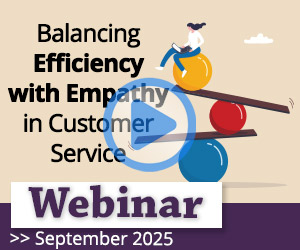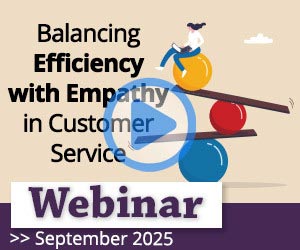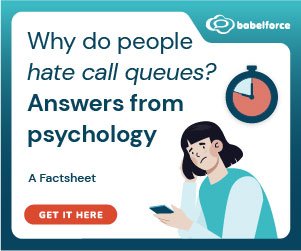It’s one of the biggest challenges in customer service: how do you stay fast and efficient in business without losing the human touch along the way?
That’s why we tackled this tough topic in our Call Centre Helper webinar – hosted by Xander Freeman – for a masterclass in turning compassion into a commercial strategy rather than a “soft skill” and a frank, research-backed look at the different sides of empathy.
Thanks to the brilliant minds of Helen Beaumont Manahan (National Support Network) and Sundeep Boughan (Puzzel), we’ve rounded up the top 10 takeaways for a reassuring reminder that empathy isn’t the fluffy optional extra some assume it to be.
1. Customers Are Living Through a Polycrisis

Helen kicked things off with a dose of reality: customers aren’t just impatient; they’re tired.
We’re living through overlapping shocks: cost of living, health anxiety, climate crisis, AI disruption.
Nearly half of UK adults (47%) now have at least one vulnerability marker, according to the FCA. That means lower resilience and thinner emotional skin when interacting with organizations.
At the same time, when you combine that with rising expectations, shrinking budgets, and other complex business issues? Empathy is usually the first casualty.
2. It’s About More Than Just “Being Nice”
Empathy is a multiplier, but Helen stressed that we have to stop using the word without anchoring it to real outcomes in order for it to be taken seriously.
When customers experience service without empathy, they feel:
- Quick but not heard: This is usually met with sympathy. It acknowledges the problem, but stays detached, more like “That’s tough” from a distance.
- Warm but unresolved: This is typically met with pity, which creates distance. “Poor you, glad I’m not you.”
- Unsafe to disclose: This one is the most dangerous. When a customer doesn’t feel safe enough to say what’s really going on, you can’t help them, and worse, you might never know the depth of what was missed.
It’s compassion, not just empathy, that makes the work sustainable by protecting the customer and the agent.
3. Experience Outweighs Service in Customers’ Minds
“Service is what gets done in the moment. Experience is what gets remembered afterwards.”
When a customer’s problem gets solved technically but the experience felt cold, rushed or robotic, customers still leave the interaction upset, unheard, or unseen.
- 78% of people in the UK feel frustrated when dealing with customer service
- 82% have had to repeat themselves across channels
- Emotional loyalty (not just problem-solving) is what drives retention
So, what’s the cost of missing empathy?
- Higher repeat contact rates
- Poor emotional loyalty
- Escalations
- Lost customers despite “successful” resolutions
You can do everything “right” from a process standpoint and still lose the customer if the interaction feels cold.
4. When Metrics Start Punishing Empathy, You’ve Already Lost
This part hit home, as Helen highlighted many of the classic traps we see that damage service, including:
- Rigid AHT targets that reward rushing
- Script adherence that leaves no space for nuance
- QA scorecards that check boxes, not emotional impact
This is Goodhart’s Law in action: “When a measure becomes a target, it stops being a good measure.”
If you optimize for speed, agents go faster, sure – but customers won’t come back.
5. Empathy Overload Is Real, and It’s Costing Your Best People
Here’s the part that most execs miss: frontline staff aren’t apathetic. They’re absorbing emotional distress all day long, with no decompression, no support, and often no guidance.
And that’s how you get empathy burnout! Without boundaries, training, or recovery time? The most emotionally intelligent people leave first.
As Helen said, “It’s not empathy that exhausts us. It’s empathy with no outlet!”
So, what’s the alternative?
Train it, protect it, and create systems that make emotional work doable, not draining.
For advice on helping agents recover, read our article: 10 Quick Wins to Help Agents Recover From a Tough Day
6. NNCA: The 4-Step Empathy Model
Helen’s biggest takeaway was a framework every service team could use – the NNCA model:
- Notice: Tune in to signals such as tone, pauses, behaviour
- Name: Acknowledge the emotion without going into scripts
- Contain: Hold space with boundaries, not burnout
- Act: Move the conversation forward with clarity and care
This practice could become second nature to your agents, with the right tech, recovery, and training.
7. Stop Relying on Outdated Models of Empathy
Helen also mentioned that this replaces the old “fast/cheap/good” triangle with one that actually fits modern service. The real triangle, in her valuable opinion, should be as follows:
- Efficiency = Do things right
- Effectiveness = Solve the real issue
- Empathy = Make it feel human
All three matter, and they’re not at odds with each other, they’re interdependent. She noted: “Customers should leave feeling both seen and sorted.”
8. Don’t Fear AI, Use It to Scale Moments That Matter

Next up in the webinar was Sundeep, with the mantra:
“Automate when it matters. Bring empathy when it really matters.”
He broke down why so many AI deployments fail:
- Most companies are starting with tech, not insight
- They deploy solutions without actually understanding the problems
- And they lack the qualitative data to know where empathy is breaking down
He also mentioned that only 1 in 3 companies move beyond the AI pilot phase, and only 1% actually scale AI with real impact. Why?
Because they skipped the most important step: diagnosing with data before automating.
9. Seek Out Real-World Proof of Where AI Is Empowering Humans (Not Replacing Them)
Sundeep shared a series of real-world examples that perfectly captured how technology can enhance, rather than replace, human connection.
- In the insurance sector, for instance, AI bots now guide customers through the first steps of a claim, freeing up agents to focus on the more emotionally charged and complex cases that truly require empathy and understanding.
- In social housing, voicebots are trained to pick up on critical words such as “mould” or “asthma”. When they do, calls are automatically routed to specially trained agents, ensuring tenants receive the right kind of help faster and with greater care.
- And in the utilities industry, speech analytics tools listen for cues that suggest vulnerability, such as mentions of children or financial strain, allowing teams to respond with empathy before the situation escalates.
These were key examples of AI empowering humans, not replacing them.
10. Make an Action Plan That Drives Real Progress
To wrap, Sundeep laid out a roadmap for any CX leader navigating this balance:
- Start with insight, not assumptions: Don’t automate just because you can. Use data to find the real drop-offs.
- Don’t chase 50/50, chase the right mix for the moment: Every channel, product and persona will need different ratios. Maturity is knowing when to flex.
- Use AI to empower, not replace: Let it handle repeatable tasks so your humans can shine where it counts.
- Close the loop: Pilot, test, learn, adapt. The data will show you what’s working if you’re listening.
Top Tips From the Audience
During our webinars, we also love to hear what our audience has to say!
“We use the CUHR model: Care, Understand, Help, Resolve.” – Dale
“Most of us just want to feel heard. It’s important to acknowledge how the member is feeling and show support and partnership in resolving the issue.” – Sabrina
“Be sure to say the caller’s name during the conversation. This makes it more personal.” – Carolyn
“It’s important to express genuine empathy in the call centre environment because customers can tell when empathy is scripted or just to check a box.” – Patrick
“Showing empathy is more than just using empathetic phrases. It involves also using appropriate timing and tone of voice.” – Emily
“Displaying empathy and compassion doesn’t always mean telling the customer what they want to hear. It means guiding them toward the best path to resolving their issue. This can and should be delivered with kindness, but it’s important not to shy away from difficult truths as we risk causing further consumer harm.” – Danii
“Focus on asking good questions. Your empathy will follow naturally when you understand the customer and their wants and needs in the given moment.” – Helge
“Listen to understand, not to respond. Focus on their words, tone, and emotion, not your next reply. This helps you respond with the right approach: empathy, compassion, or clear guidance.” – Kathy
“Connect to the feeling, not the situation. Instead of searching for how you can relate to someone who has lost a family member when you never have, search back to when you felt a similar feeling, like sadness or confusion. Allow yourself to become vulnerable. By doing this, true empathy will shine.” – Emily
“Avoid over-apologizing. One sincere apology is enough – then move to a solution. Too many ‘sorrys’ can waste time and weaken confidence.” – Mary
You Don’t Have to Choose Between Fast and Kind
The mic-drop from Helen?
“We design for efficiency, deliver with empathy, and measure effectiveness.”
In other words: You don’t have to choose between fast and kind!
Together, they will build loyalty, reduce rework, and protect your people.
Want to find out more? Watch the full Recorded Webinar: Balancing Efficiency With Empathy in Customer Service here!
For more great advice on developing empathy in the contact centre, read these articles next:
- What’s Really Ruining Empathy in Customer Service?
- How to Limit Agent Burnout With Empathy-Led Leadership
- How to Develop Empathy as a Skill in Your Frontline Teams
Author: Stephanie Lennox
Reviewed by: Jo Robinson
Published On: 25th Nov 2025
Read more about - Hints and Tips, Artificial Intelligence (AI), Call Handling, Customer Engagement, Customer Expectations, Customer Experience (CX), Empathy, Employee Engagement, Employee Experience (EX), Health Wellbeing and Stress, Helen Beaumont Manahan, Puzzel, Skill Development, Soft Skills, Stephanie Lennox, Technology Enablement Strategy, Top Story





































